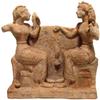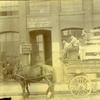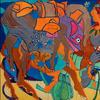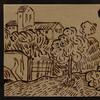Masterpieces of 17th-19th-Century British Design to be the Focus of New Exhibition at the Art Museums of Colonial Williamsburg
- WILLIAMSBURG, Virginia
- /
- January 28, 2020
When the first curators at Colonial Williamsburg began to buy objects for the collection 90 years ago, they acquired what they believed at the time to be appropriate for furnishing the buildings being restored in the historic town. These pieces of historical importance and intrinsic beauty were assembled into what we now refer to as the Colonial Revival style. It was the vision of philanthropist John D. Rockefeller Jr., who financed Colonial Williamsburg’s restoration, that these objects “should become second to no collection of its kind in the country.” Nearly 50 years later, research conducted by the next generation of curators indicated that Virginia colonists preferred to furnish their houses in the “neat and plain” style rather than the high-style English antiques that by then graced Historic Area interiors. As a result, significant examples of British fine art and decorative arts were removed from the Historic Area buildings and replaced with more appropriate objects and have not been on public view for many years. This will change when British Masterworks: Ninety Years of Collecting at Colonial Williamsburg opens on February 15, 2020, at the DeWitt Wallace Decorative Arts Museum, one of the Art Museums of Colonial Williamsburg. Approximately 46 objects ranging from portraits to furniture to ornate decorative arts include an extraordinary portrait of Queen Elizabeth I, an ornately inlayed jewelry box presented to Colonial Williamsburg by Queen Elizabeth II, an exceptional baroque chandelier and pier table likely inspired by William Kent among other spectacular pieces. The exhibition will remain on view through December 2022.
“The majority of exhibitions at the Art Museums focuses on and reinforces the foundation’s mission of sharing early America’s story through objects that tell important stories,” says Ronald L. Hurst, Colonial Williamsburg’s vice president for museums, preservation and historic resources and the Carlisle H. Humelsine chief curator. “British Masterworks offers an opportunity to highlight the aesthetic qualities of these objects and Colonial Williamsburg’s deep history of collecting.”
Organized chronologically from earliest to latest, the high-style pieces showcased in British Masterworks were selected by Mr. Hurst and Margaret Beck Pritchard, deputy chief curator, who co-curated the exhibition. Most were chosen particularly for their beauty, craftsmanship and state of preservation.
“Selecting the objects for this exhibit was a fabulous experience,” said Ms. Pritchard. “All of the pieces we chose reflect our shared aesthetic response to beauty and craftsmanship.”
Among the highlights of British Masterworks is a portrait of the Virgin Queen, Elizabeth I (for whom the colony of Virginia was named) that was painted in London between 1590 and 1600 by an unknown artist. Queen Elizabeth I was crowned in 1559 and ruled Britain until her death in 1603. This commanding likeness of the monarch was inspired by the 1575 Darnley portrait, which may have been her officially sanctioned image. Most portraits made after that date copy the Darnley version of her face, but place it in varying costumes and backgrounds. In this painting, the unidentified artist skillfully depicted the queen in a lavish velvet gown with richly embroidered white satin sleeves. Her bodice and skirt are heavily set with pearls, rubies, sapphires and other gemstones, and her signature white neck ruff frames her face.
Another featured object in the exhibition is a jewelry or dressing box with a long history of ownership in England that was presented to Colonial Williamsburg by Queen Elizabeth II in 1957 to mark the 350th anniversary of the Jamestown settlement. Made in Puebla, Mexico, between 1660 and 1710, this ornate box, veneered in tortoiseshell, has mother-of-pearl motifs that include an eagle, wolf, badger, beaver, armadillo, stag, griffin and elephant as well as an allegorical figure of America. The box illustrates the intersection of Asian, Mexican and European traditions in the colony of New Spain (or Mexico) during the late 17th century. New Spain was then a cultural crossroad through which exotic Asian goods traveled en route from the Pacific to Europe influencing local taste. European imports, immigrant craftsmen and Native American motifs added to the mix that together contributed to a distinctive aesthetic. The maker’s choice of mostly native Mexican fauna and “America” suggest that the box was originally produced for a wealthy Spaniard with ties to New Spain.
British Masterworks features several important examples of English furniture including this marble-topped pier table made ca. 1735. Likely inspired by the work of William Kent, a leading English architect and designer who studied Italian art and architecture and introduced the Palladian style to England at the start of the 18th century. Stone-topped pier tables were commonly placed on narrow walls between two windows and displayed beneath large, vertical looking glasses. In this example, the central carved mask, foliate swags, scrolled legs and fish scale motifs carved into the sides of the legs are all hallmarks of Kent’s classically inspired designs.
Thomas Chippendale suggested in his 1762 design book that chandeliers “if neatly done in Wood, and gilt in burnished Gold would look better, and come much cheaper” than brass or glass examples. This chandelier, made ca. 1760, is another highlight of the exhibition and has a history of use at Benningborough Hall in Yorkshire, England. It exemplifies in exceptional style the important feature of asymmetry in rococo design that very few English objects exhibit to the fullest. The chandelier has stylized interpretations of shell, rock and scroll motifs. When lit by flickering candles, it gave the appearance of movement.
British Masterworks: Ninety Years of Collecting at Colonial Williamsburg was generously funded by Don and Elaine Bogus.
For British decorative arts aficionados, British Masterworks is an exhibition not to be missed. It confirms that the Colonial Williamsburg collection achieved Mr. Rockefeller’s vision of having a second-to-none assemblage of British and American decorative arts that visitors can now enjoy.
The Art Museums of Colonial Williamsburg remain open during construction of an entirely donor-funded $41.7 million expansion. Additional information about the Art Museums and Colonial Williamsburg as well as tickets are available online at colonialwilliamsburg.com, by calling (855) 296-6627 and by following Colonial Williamsburg on Facebook and @colonialwmsburg on Twitter and Instagram.
About the Art Museums of Colonial Williamsburg
The Art Museums of Colonial Williamsburg include the Abby Aldrich Rockefeller Folk Art Museum and the DeWitt Wallace Decorative Arts Museum. The Abby Aldrich Rockefeller Folk Art Museum, celebrating its 60th anniversary in 2017, is home to the nation’s premier collection of American folk art, with more than 7,000 folk art objects made during the 18th, 19th and 20th centuries. The DeWitt Wallace Decorative Arts Museum exhibits the best in British and American fine and decorative arts from 1670–1840. The Art Museums of Colonial Williamsburg are located at the intersection of Francis and South Henry Streets in Williamsburg, Va., and are entered through the Public Hospital of 1773. Expansion of the museum broke ground on April 27, 2017. Once completed, the museums’ expansion will provide a new entrance, improved public access, increased exhibition space and guest services among other enhancements. Museum hours are 10:00 a.m. to 7:00 p.m. daily.
About The Colonial Williamsburg Foundation
Colonial Williamsburg operates the world’s largest living history museum, preserving Virginia’s 18th-century capital as a fully functioning city. Fun, engaging experiences transport guests back in time and highlight the relevance of America’s founding era to contemporary life. The Colonial Williamsburg experience includes more than 600 restored or reconstructed buildings, historic trade shops, renowned museums of decorative arts and folk art, extensive educational outreach programs for students and teachers, lodging, culinary options from historic taverns to casual or elegant dining, the Golden Horseshoe Golf Club featuring 45 holes designed by Robert Trent Jones Sr. and his son Rees Jones, a full-service spa and fitness center managed by Trilogy Spa, pools, retail stores and gardens. Philanthropic support and revenue from admissions, products and hospitality operations sustain Colonial Williamsburg’s educational programs and preservation initiatives.
# # #
Contact:
Robyn LiverantRobyn Liverant Public Relations
robyn@robynliverant.com

100x100_n.jpg)














